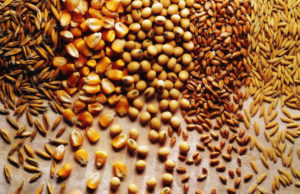 Grain futures rose on Friday amid concerns that dry weather in the Midwest U.S., the largest producing region, may hurt crop yields.
Grain futures rose on Friday amid concerns that dry weather in the Midwest U.S., the largest producing region, may hurt crop yields.
On the Chicago Board of Trade, corn futures for delivery in September jumped to $4.9163 per bushel at 9:33 GMT, up 0.70% on the day. Prices ranged between days high and low of $4.9313 and $4.8888 per bushel respectively. The grain rebounded after plunging more than 2% on Thursday and extended its current weeks advance to 3.7%.
Meanwhile, soybeans for September delivery stood at $13.3000 per bushel at 9:33 GMT, marking a 0.57% advance. Prices ranged between days high and low of $13.3663 and $13.2663 a bushel respectively. The oilseed rose to a 1-month high on Thursday but settled the day 0.5% lower. Fridays rebound however extended its weekly decline to over 3.6%.
Corn and soybeans advanced on Friday on speculation that the USDA may further trim its production estimate after revising it downward on August 12. According to a Bloomberg survey of eight participants in the Professional Farmers of America Midwest Crop Tour, the U.S. Department of Agriculture will probably reduce its soybean-crop estimate by 2.5%, while corn production forecasts are expected to be trimmed by 1.5%.
The government agency recently cut its corn and soybean projections after wet weather conditions in May and June delayed planting, exposing plants at risk of frost. On August 12, the USDA shrank its U.S. corn output forecast to 13.763 billion bushels, 1.3% below its July estimate at 13.950 billion. Stockpiles are also poised to drop and will equal 1.837 billion bushels, 6% below July’s 1.959 billion projections. Soybeans production forecast was revised downward to 3.255 billion bushels, 5% below July’s 3.42 billion estimate, but still 8% higher than a year earlier. Yields expectations were also reduced and now stood at 42.6 bushels per acre, below the previous reading of 44.5 bushels and analysts’ projections for a 43.6 output per acre.
Soybeans were supported throughout the week as inspections showed yields may be lower than the three-year average. The inspected by the tour soybeans fields in Nebraska showed an average of 1 138.9 pods per each 3-by-3 feet plot, well above last year’s 894 pods. In Indiana, inspections showed an increase to 1 185 pods on average, compared to 1 033 a year earlier. However, the reported figures were lower than the three-year average of 1 162 pods per three square feet, which supported prices.
The USDA reported on Monday that soybeans condition has worsened last week. As of August 18, 10% of plants were rated very poor-poor, compared to 9% in the previous week and 37% a year earlier. Meanwhile, 36% were categorized as “Fair”, above the preceding five-day period’s 34% and below 2012′s 53%. As for the premium quality, 62% of the crop was rated good-excellent, marking a 2% decline from a week earlier but still well above last year’s 31%.
Bennett Meier, a New York-based market analyst for Morgan Stanley, said for Bloomberg: “There is more variability in corn and soybeans than I expected before this week’s tour. The crop is immature and at increased risk of damage from freezing temperatures and crop losses” in September or early October.”
Elsewhere on the market, wheat also rose. The September contract traded at $6.3150 per bushel at 9:30 GMT, up 0.14% on the day. Prices ranged between days high and low of $6.3300 and $6.2850 a bushel respectively. The grain slipped 1.2% on Thursday but erased its previous weekly losses following Fridays rebound.
The USDA reported on Monday that the winter wheat harvest is nearing completion and has surpassed the five-year average pace. AS of August 18, 96% of the crop was harvested, marking a 4% advance from the previous week. This was above the five-year average pace of 94% and 1% below last year’s 97%.
As for the spring wheat crop, harvesting fell well behind 2012′s pace. As of last week, 18% of the production was harvested, below both the five-year average and last year’s readings of 38% and 77% respectively. Crop condition remained overall the same compared to a week earlier with 66% of spring wheat categorized as “Good” and “Excellent”. Information about last year’s quality was not provided.





